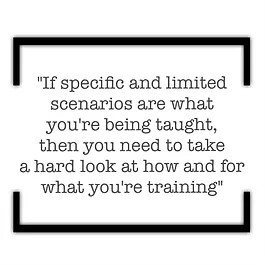


Every karate, Judo, MMA, BJJ, Systema, and Krav Maga school is going to profess their perspective of self-defense. If they didn’t, they wouldn’t be doing what they love and teaching what they teach. Even larger than the differences between schools are the different perspectives of self-defense, which can be great enough to differentiate entire styles from each other. Some perspectives are more complicated than others and some still use the term “self-defense” when they fully know they are a tournament-based school training for rules rather than a life-threatening violent encounter.
Over more than two decades of training, I’ve had the opportunity to train across various styles (some more “martial” than others) and have developed the foundation for our perspective of what self-defense is and how we train for it. At Krav Oz, our self-defense mindset is based on five basic pillars: principles, the toolbox, transitions, training style and the Spectrum.
Before I detail each of these, let me be very clear about how we define self-defense at Krav Oz. For us, self-defense is “ultimately the creation of space and time to get home safely to your family”. (There’s a slight difference for law enforcement and military, but the principle is still the same). It’s not long-winded, it’s not sexy. It’s real. True self-defense is not standing around waiting for a prolonged street boxing match; self-defense is not “peacocking” until someone is laying face-down on the concrete. Self-defense (as opposed to self-protection) is fast, violent, and not what you see in the movies.
“If the attacker sends a left-handed punch at a 37° angle, when you’re standing on a grassy hill at a 12° grade that was rained on 3.6 hours ago, then do this defense and counter.” If specific and limited scenarios are what you’re being taught, then you need to take a hard look at how and for what you’re training. Having spent my childhood and early adult life in the traditional martial arts, I’m used to archaic techniques that I know would never work in a true self-defense altercation. It’s not that all of them are necessarily bad, but the rote memorization of techniques eventually leads to an overload that causes delays in responding under stress.
Krav Oz teaches the principles of violent encounters and applicable responses to them. Of course we teach techniques, but there are a few things that need to be considered when teaching technique that make teaching principles that much more important:
1. Technique: None of my students will ever perform the technique like me. Not because I’m any better than them, but because their height, weight, flexibility, strength, etc. are all unique to them and they have to take the technique I’m teaching and make it their own based on their body;
2.Preference: Each of my students has their preference for techniques they like to use and that forms the foundation of their self-defense “style”. Again, this has almost nothing to do with me and my teaching, but a personal preference based on an affinity to certain techniques, previous training and/or physical limitations;
3. Baggage: Each student comes with “baggage”. Whether it’s good (or bad) baggage from previous training or baggage they would rather not have due to a previous violent encounter (or anything in between), this “baggage” will have a real affect on their training and application of techniques.
If my plan is to teach thousands of individual techniques to cover every possible angle, scenario, strike and counter, AND I know that each student is going to alter them based on at least one of the three elements listed above, then I could spend a lifetime teaching a single student before they’d ever feel comfortable.
However, if I teach principles, I can be much more effective for my students. And that is how we teach at Krav Oz. Once some basics are understood, we rely heavily on the principles of balance, weight-shifting, risk-reward, targeting, distance, transitions, objective and relative positioning, and violence. By emphasizing these principles, any student can perform a punch that works perfectly for them, or transition from a body-lock defense to a knife-threat defense without thinking about it, or apply situational awareness to avoid a confrontation all together (self-protection).
Violent confrontations and encounters are unpredictable, rapidly evolving situations that can only be controlled so much (anybody telling you that "90% of fights do 'this' or 'that' does not understand true violence). As much as consistent training will help a self-defense practitioner control where a specific encounter may go, the reality is tat just the instantaneous violence between two (or more) individuals (think Tasmanian Devil here) will create an infinite number of situations and possibilities. Because of this, Krav Oz believes in training to develop the best toolbox that we can. Just as a carpenter needs to pull a wrench, hammer, or screwdriver out of their toolbox for different jobs, someone in a violent encounter may  need to pull a Krav Maga choke defense, a Judo trip, a boxing punch, or a BJJ arm-bar out of their toolbox. Restricting your toolbox to one type of tool inherently limits your ability to address an unpredictable, rapidly evolving situation that may not give you time to think.
need to pull a Krav Maga choke defense, a Judo trip, a boxing punch, or a BJJ arm-bar out of their toolbox. Restricting your toolbox to one type of tool inherently limits your ability to address an unpredictable, rapidly evolving situation that may not give you time to think.
Our Krav Maga and self-defense program focuses on giving our students the best toolkit possible. Starting with basic strikes and defenses, students quickly work to develop an understanding of pressure and resistance, basic boxing and Muay Thai, wrestling, grappling standing or on the ground, and weapons defenses. Our perspective keeps the curriculum simple, but stresses application.
I can teach anyone to throw a punch. I’ve worked with great Muay Thai instructors who can teach anyone to throw a beautiful round kick. I’ve been a student of the best BJJ instructors in the world who can teach anyone to lock in a perfect arm bar. As much as each of these individual techniques are amazing to know, beautiful to watch, and have real self-defense application, the reality is that none of these – especially in a violent, unpredictable, rapidly evolving situation – live in a vacuum. No attacker is going to let you get a clean punch to the face just like they won’t let you sink in that arm-bar without trying to bounce your head off the concrete a few times.
Because we know that’s the case, Krav Oz takes specific pride in focusing on transitions between all the areas a fight may go. If the fight is going to be rapidly evolving, then I need to evolve with it (and typically faster than it). I don’t care if you can throw the single greatest punch in the world, but if you don’t know how to transition to a double-leg take-down, a groin kick, or any other viable option because your opponent moved or blocked your punch then your abilities are limited. Our training never relies on the idea that my first strike will end the fight because that assumption could put me into greater danger, therefore I always have to know how to transition should the fight continue. If my self-defense techniques (punches, kicks, take-downs, etc.) are the tools in my toolkit, then the transitions between tools are the blueprints. If we agree that violent encounters are unpredictable and rapidly evolving then we have one of two options:
1. Lead the evolution of the fight to create space and time or
2. Use our transitions to react to the evolution (and work our way back to option 1).
Regardless, we MUST BE ABLE TO TRANSITION!
In a violent encounter, battles (individual exchanges) are won through techniques, but the war (the encounter as a whole) is won with transitions.
Like many other endeavors, self-defense is a perishable skill: if you don’t practice it, you lose it. Like shooting, writing poetry, or singing, the more time you stay away from it, the less a part of you it is, but the more you persist the better you become. If you train properly, you will continuously reinforce old, and build new, skill sets.
Krav Oz believes heavily in the application of principles and techniques. As I spoke about previously, anyone can throw a single great punch, or lock in the perfect arm-bar with enough practice, but if it’s done in a vacuum, then its applicable benefits are only so much. From Day One, our students apply techniques and principles through various application drills. This type of training serves as immediate reinforcement, builds confidence and forces students to apply principles and transitions immediately.
This leads us to the last pillar of our self-defense perspective...
Because we understand most people don’t train self-defense for a lifetime, it is our responsibility to make our students as skilled as possible as quickly as possible. Training technique is easy (and has its issues), but “easy” doesn’t create growth. Our students fundamentally trust me and my instructors to help them grow – an endeavor we take very seriously – and we do it through the lens of “the Spectrum”.

On the one end of the Spectrum we have the same karate class that we all took when we were 5-years-old: safe, easy, unrealistic. On the other end of the Spectrum we have an all-out, fight-for-your-life encounter where the attacker is trying to make sure you don’t get home to your family. The instructors at Krav Oz are tasked with bringing those ends of the spectrum progressively closer for each student throughout their training.
Level 1 is designed to physically challenge any new student and introduce them to stress and application. Level 2 increases the stress and provide new environments for the fight. Level 3 starts to introduce multiple attackers, and Level 4 starts introducing weapon defenses. All the while, stress is increasing and students are relying on principles more than anything else. However, the two ends of the spectrum will never fully overlap as this gap will ALWAYS house the principles of control and safety-in-training.
The Spectrum is designed to continuously push our students. We will never force them to do anything they are not comfortable doing, but we believe that growth only comes from stepping outside your comfort zone and rising to a new level. We challenge our students with bringing the two ends of the Spectrum closer together so they can ultimately be comfortable being uncomfortable.
We love what we do at Krav Oz. We love having the opportunity to work with students from all walks of life and experience levels and share our perspective of self-defense. We continue to evolve this perspective as we learn more and work with other students and instructors.
Our perspective is not meant to be scary, but real. All of our instructors are passionate about what we do and love teaching. Classes are fun, engaging and a great workout. If you’re interested in our self-defense perspective or ready to change up your workout regimen, come in and try a class today!
Ehren Hollander is the owner of Krav Oz, Montgomery County Maryland's top self-defense school. Ehren has black belts in Krav Maga, Shotokan Karate and Aikido as well as over 20 years of training in various self-defense systems including Brazilian Jiu-Jitsu, Muay Thai, wrestling, Judo and boxing. Ehren has been honored to teach thousands of civilians, law enforcement officers and military operators over the years and is committed teaching real self-defense.

Last month, I was only going to sign up my 12 year old son but decided to sign up after taking an introductory class. Every class is different and I am learning something new each time. Chantell and Ehren are awesome trainers that push us to do our best. I would definitely recommend Krav Oz LLC to my family and friends!

I took a Women's Self Defense class with Chantell in July and instantly felt a need to continue. A few days later I signed a 12 month contract. I can't believe how far I've come since day one. Chantell and Ehren are amazing instructors. They are so passionate about what they do. Every class is better than the last. I’m constantly talking about my training with my friends and family. I would highly recommend Krav Oz LLC. I don’t know how they do it but I leave every class with a huge smile on my face. Thank you, Chantell and Ehren!

I recently attended Krav Oz's Self Defense seminar in Rockville - and it was fantastic! A comprehensive four hours covering everything I could want, and at just the right speed to keep me and the other attendees challenged and engaged. From start to finish, Chantell and Ehren provided excellent instruction; without sacrificing the skill and passion they possess for their field, Chantell and Ehren created an encouraging and stimulating environment fueled by real life, practical examples in the lecture portion, and helpful analogies to make the defense moves in the self-defense portion hit home (pun intended). In short, this seminar was one from which all could benefit - whether you've never heard of Krav Maga, or have spent years on the mats. Can't wait to come check out a class!